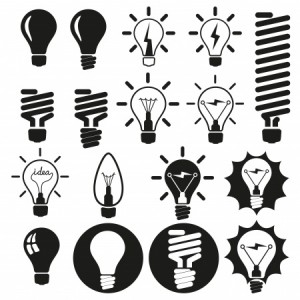With so many technological advances during the last 20 years, it can be difficult to keep up with the latest trends and innovative new products. An example of this can be found in a product that many of us use and depend on each and every day: light bulbs. Historically, the only thing you had to worry about when purchasing a light bulb was the size and how many watts you needed for your lamp or ceiling light. Today however, there an array of choices, some uniquely designed, for homeowners to choose from. But what should your process be for choosing the right one? Hopefully, the tips and information below can help you out.
1) Research. In order to best determine which light bulb would suit your needs, do research on the features and benefits of a  desired bulb. For example, some bulbs may cost more than other options, but they also may be more efficient, affording you savings over a longer period of time. Other light bulbs may feature dimming capabilities, while some may shine better than others. Contemplate which type of light bulb would best suit your needs, then research your options.
desired bulb. For example, some bulbs may cost more than other options, but they also may be more efficient, affording you savings over a longer period of time. Other light bulbs may feature dimming capabilities, while some may shine better than others. Contemplate which type of light bulb would best suit your needs, then research your options.
2) Read the “nutritional” section on the back of the box. For those who may not have the time or means to research on the internet, you can simply make a trip to the store and read up about different bulbs on the back of their box. Similar to boxed foods that feature a nutritional outline on the back of their packages, all new light bulb boxes contain a comparable informative section. The information on the back of the boxes includes brightness levels, energy costs, life expectancy, warm or cool appearances, wattage and mercury content. New packages may also provide consumers with more useful insights, such as providing a color coding system that shows you what to expect when purchasing a specific bulb. This information well help you make your selection.
3) Know the terms. Consumers that understand some of the different terms in the lighting industry will be less likely to make a regrettable purchase. For your convenience, we outlined a few of the more prevalent terms you will see below:
– Incandescent Bulbs. These are your traditional light bulbs that are both inexpensive and easy to find, yet are in less demand due to more energy efficient options being on the market. These bulbs produce light after an electric current interacts with a filament wire, causing the bulb to light.
– Halogen Bulbs. Halogen bulbs are able to be operated at a higher temperature than normal bulbs, which allows them produce a brighter light, yet they last longer than more traditional bulbs. They are only available in line voltage and low voltage, and make sure to be careful unscrewing them….they can get hot!
– Fluorescent Bulbs. Fluorescent bulbs are renowned for their efficiency. Despite using less electricity than traditional bulbs, they can last up to twenty times longer. Moreover, these bulbs can be used in place of traditional bulbs in most fixtures.
– LED bulbs. LED bulbs are renowned for their long life expectancies, although they often cost more than the aforementioned bulbs.
